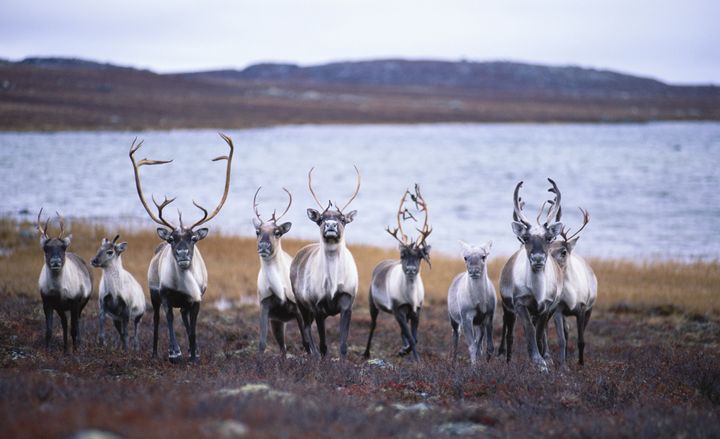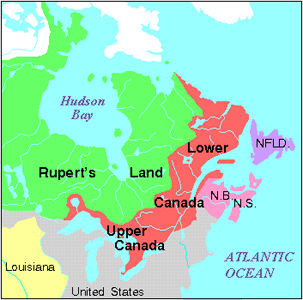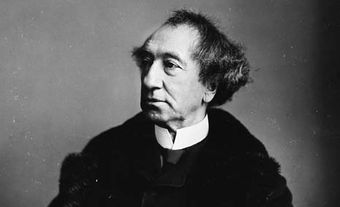Northwest Territories
The Northwest Territories lie northwest of central Canada, bordered to the east by Nunavut, to the west by the Yukon and to the south by the northeastern corner of British Columbia, as well as the entire northern borders of Alberta and Saskatchewan.

-
July 31, 1868

Government and Politics
Rupert's Land Act
The Rupert's Land Act was passed, allowing the Crown to declare Rupert's Land part of the Dominion of Canada.
-
December 01, 1869

Government and Politics
HBC Surrenders Rupert's Land
The Hudson's Bay Company surrendered Rupert's Land to the Canadian government.
-
July 15, 1870

Government and Politics
Transfer of Rupert's Land
The British Crown officially transferred Rupert's Land and the North-Western Territory to Canada. These lands comprise present-day Manitoba, most of Saskatchewan, southern Alberta, southern Nunavut, and northern parts of Ontario and Québec.
-
September 01, 1880

Government and Politics
Arctic Sovereignty
British sovereignty over the Arctic Islands passed to Canada.
-
January 01, 1885
Government and Politics
Northwest Territories Women Disenfranchised Municipally
Women in the Northwest Territories (including what later became Alberta and Saskatchewan) were barred from voting in municipal elections or holding municipal office, but were allowed to vote for, and become, school trustees.
-
March 30, 1885

People
Cree Attack Battleford
Two hundred Cree under Poundmaker ransacked Battleford, NWT, and laid siege to the fort.
-
April 24, 1885

People
Battle of Fish Creek
General Middleton engaged Gabriel Dumont's Métis at Fish Creek, NWT; the battle was a stalemate.
-
May 21, 1887
People
Birth of James Gladstone
James Gladstone, Canada's first Indigenous senator, was born at Mountain Hill, NWT.
-
July 14, 1892
People
Birth of Jack Sissons
Judge Jack Sissons was born at Orillia, Ontario. As the first judge of the Territorial Court of the Northwest Territories, Sissons took "justice to every man's door" by aircraft and dogsled.
-
January 01, 1895
Government and Politics
Yukon is Named one of Four NWT Districts
Canada named Yukon one of four districts within the Northwest Territories, along with Mackenzie, Franklin and Ungava. The capital of the territory was in Regina, but Yukon people sought more control over their affairs.
-
June 24, 1897

Government and Politics
Cabinet Government in NWT
Full Cabinet government was established in the North-West Territories, and F.W. Haultain formed its first government.
-
May 06, 1898
People Resources and Environment
Yukon Field Force
The Yukon Field Force, consisting of 203 volunteers, left Vancouver for Dawson to maintain order during the Klondike Gold Rush.
-
June 13, 1898

Government and Politics
Yukon Becomes Separate Territory
By Act of Parliament the Yukon became a separate territory with a commissioner and partly elected council.
-
March 16, 1918

Government and Politics
NWT Divided Into Districts
The Northwest Territories were divided into the present Districts of Keewatin, Mackenzie, and Franklin, and brought into the Dominion of Canada; effective 1 January 1920.
-
June 27, 1921

Indigenous Peoples
Indigenous People Cede Mackenzie
Slave, Dogrib, Hare, Loucheux and other bands ceded the Mackenzie River region of the Northwest Territories to the federal government.
-
January 01, 1922

Resources and Environment
Wood Buffalo National Park Established
Wood Buffalo National Park was established to protect the last herd of wood bison. Canada's largest national park straddles the Alberta-Northwest Territories border. It was declared a world heritage site in 1983.
-
November 12, 1925
Indigenous Peoples Sports and Culture
Birth of Agnes Nanogak
Graphic artist Agnes Nanogak, whose narrative prints and drawings evoke a rich variety of stories reflecting the Mackenzie Delta/Copper Eskimo culture, was born on Baillie Island, NWT.
-
December 28, 1929
Communication and Transportation
Airmail Service to the Arctic
Pilot Wilfrid May flew the first official airmail to Canada’s Arctic, delivering it to Aklavik, NWT. The new airmail service route covered over 2,500 kilometers.
-
May 16, 1930

Resources and Environment
LaBine Finds Uranium
Prospector Gilbert LaBine discovered pitchblende, the chief source of uranium and radium, at Great Bear Lake, NWT.
-
January 01, 1940
Government and Politics
Municipal Government in NWT
The first municipal government in the Northwest Territories was inaugurated in Yellowknife.
-
October 17, 1948
Sports and Culture
Birth of Margot Kidder
Movie actor Margot Kidder, who achieved widespread recognition as reporter Lois Lane in the four Superman movies, was born at Yellowknife, NT.
-
March 25, 1951
Indigenous Peoples People
Birth of Ethel Blondin-Andrews
Ethel Blondin-Andrews, first Indigenous woman elected to Parliament, was born at Fort Norman, NT.
-
June 12, 1951
Government and Politics People
Northwest Territories Women Get Vote
Women in the Northwest Territories won the right to vote and stand for office.
-
November 18, 1964
Communication and Transportation Resources and Environment
Lead-zinc Shipped from NWT
The first shipment of lead-zinc ore left Pine Point, NWT, destined for smelters in Trail and Kimberley, BC, over the recently completed Great Slave Lake Railway.
-
March 11, 1969
Communication and Transportation
Last RCMP Dog Sled Patrol
The last RCMP dog sled patrol, which mostly carried mail and medical supplies across the Yukon and Northwest Territories, set out on a final 800 km round trip from Old Crow, YT. Constables Warren Townsend and Peter Benjamin made the trip in 26 days with two dog teams. The RCMP had recently announced that its last dog sled teams would be replaced with snowmobiles and aircraft.
-
August 24, 1969
Communication and Transportation
Manhattan in the Canadian Arctic
The US oil tanker Manhattan left Chester, Penn, on a trial voyage through the Northwest Passage. With the assistance of the Canadian icebreaker CCGS John A. Macdonald, the Manhattan reached Sachs Harbour, NWT, on September 15.
-
March 09, 1970
Sports and Culture
First Arctic Winter Games
Prime Minister Pierre Trudeau opened the first Arctic Winter Games in Yellowknife, NWT.
-
June 23, 1970
Government and Politics
100th Anniversary of the Northwest Territories
The Queen visited remote communities along the Arctic Circle with Philip and her two eldest children, Charles and Anne. This high-profile tour officially marked the 100th anniversary of the Northwest Territories. But it also provided the Queen with the opportunity to engage with the Inuit and to affirm Canada’s sovereignty over the Arctic through her presence in the region.
-
December 21, 1970
Government and Politics People
First Woman Elected to the Northwest Territories Council
Lena Pedersen became the first woman elected to the Northwest Territories Council.
-
January 20, 1971
Communication and Transportation
Radio Tuktoyaktuk Goes On Air
Radio Tuktoyaktuk (Northwest Territories) began broadcasting, in both English and Inuktitut, bringing radio service to approximately 650 residents of the Mackenzie River Delta and introducing Indigenous-language broadcasting to Canada.
-
December 09, 1972
Disasters
Pilot Hartwell Found Alive
Amazingly, bush pilot Martin Hartwell was found alive, a month after his plane crashed in the Northwest Territories. He had survived that long (with two broken ankles and in harsh winter temperatures) thanks to the efforts of the one surviving passenger, a 14-year-old boy named David Kootook, who lived for several weeks after the crash but died before Hartwell’s rescue.
-
March 18, 1973

Indigenous Peoples
First Reserve in NWT
The first First Nations reserve in the Northwest Territories was created at Hay River.
-
September 07, 1973
Indigenous Peoples
NWT Court Allows Land Claim
The Northwest Territories Supreme Court allowed the Indian Brotherhood of the NWT to file a land claim for one-third of the NWT.
-
February 28, 1975

Government and Politics
NWT Gets Second Seat
Legislation was passed granting the Northwest Territories a second seat in the House of Commons.
-
January 01, 1976
Government and Politics
Nunatsiaq Riding Created
A federal riding was created in the Northwest Territories. Called Nunatsiaq, it represented territory that now comprises Nunavut.
-
January 01, 1976

Resources and Environment
Nahanni National Park Reserve Established
Nahanni National Park Reserve was established. The park is a wilderness of rugged mountains, wild rivers and luxurious hot springs stretched along the South Nahanni River in the southwest corner of the Northwest Territories. The park was recognized as a United Nations World Heritage Site in 1978.
-
January 01, 1976
Indigenous Peoples
Nunavut Land Claims Presented to Government
The Inuit Tapirisat of Canada submitted a formal land claims proposal to the Government of Canada.
-
August 14, 1978
Indigenous Peoples
Dene Nation
The Indian Brotherhood of the Northwest Territories became the Dene Nation during the 8th Dene National Assembly held in Fort Norman, NT.
-
January 01, 1982
Indigenous Peoples
Tungavik Federation of Nunavut Established
The Tungavik Federation of Nunavut (TFN) was established in order to negotiate a land claims agreement with the Government of Canada.
-
April 14, 1982
Indigenous Peoples
Northwest Territories Plebiscite
The majority of voters (56 per cent) chose to divide the Northwest Territories in two in a territorial plebiscite. The division would create a mainly Inuit eastern territory. Over 80 per cent of the territory’s Inuit voted, more than 80 per cent of whom voted in favour of the creation of Nunavut. The results of the plebiscite were not binding federally.
-
June 05, 1984
Indigenous Peoples
Inuvialuit Final Agreement
After ten years of negotiation, the Inuvialuit Final Agreement (IFA) was settled in Northwest Territories. The IFA was Canada’s second finalized comprehensive land claim, and the first in the extreme North. The Inuvialuit exchanged exclusive usage of ancestral lands for guaranteed rights over land, wildlife protocols and funds.
-
January 01, 1987

Government and Politics
Iqaluit Named
The town of Frobisher Bay, NWT, changed its name to Iqaluit.
-
September 20, 1987
People
Pope Visits Fort Simpson
Pope John Paul II visited Fort Simpson, NWT.
-
November 14, 1991
Indigenous Peoples
Cournoyea Elected Premier of NWT
Nellie J. Cournoyea, of Inupiaq heritage, was elected premier of the Northwest Territories, making her the first Indigenous woman to hold the position of government leader.
-
April 22, 1992
Indigenous Peoples
Gwich’in Comprehensive Land Claim Agreement
The Gwich’in Tribal Council and the Canadian and the Northwest Territories governments signed the Gwich’in Comprehensive Land Claim Agreement. The Agreement involved lands in the Mackenzie Delta in the Northwest Territories and in Yukon. Special hunting rights were also extended, permitting the harvest of fur-bearing animals throughout the settlement area.
-
May 04, 1992
Government and Politics
Nunavut Boundary Plebiscite
A plebiscite was held in order to confirm the boundary between the Northwest Territories and Nunavut. Fifty-four per cent voted in favour of the proposed boundaries.
-
November 03, 1992
Indigenous Peoples
Inuit Accept the Terms of the Nunavut Land Claims Agreement
A majority of Inuit beneficiaries voted to accept the terms of the proposed Nunavut Land Claims Agreement. In tandem with the Nunavut Act, the land claims agreement led to the creation of the territory of Nunavut.
-
November 12, 1992
Government and Politics
Inuit Endorse Nunavut
The Inuit endorsed the creation of Nunavut, a semi-autonomous territory, in a referendum.
-
June 10, 1993
Government and Politics Indigenous Peoples
Nunavut Act Receives Royal Assent
The Nunavut Act, which established the new territory and its government, received royal assent in Parliament. The territory's Inuit population became beneficiaries under the Nunavut Land Settlement Agreement, which also received royal assent on this day. Nunavut officially became Canada’s third territory on 1 April 1999.
-
September 06, 1996
Government and Politics
Residents Keep NWT Name
Residents of the Northwest Territories voted to keep that name for the western part of territory after the eastern part became the territory of Nunavut in 1999.
-
January 01, 1998

Resources and Environment
Tuktut Nogait National Park Established
Tuktut Nogait National Park was created through the efforts of the Inuit of Paulatuk, NWT. They wanted a national park to help protect the calving grounds of the Bluenose herd of barren-ground caribou, a game animal essential to their way of life.
-
April 01, 1999

Government and Politics
Nunavut Declared
The new territory of Nunavut, covering some 2 million sqare kilometers of the eastern Arctic, was declared as part of Canada's first territorial changes since Newfoundland joined Confederation in 1949.
-
May 11, 1999
Resources and Environment
Chevron Announces Gas Find
Chevron Canada of Calgary announced that explorers had found one of the largest natural gas deposits in Canada near the town of Fort Liard, NWT.




